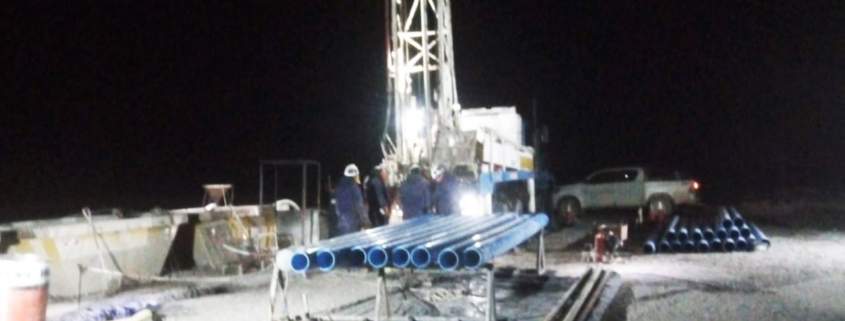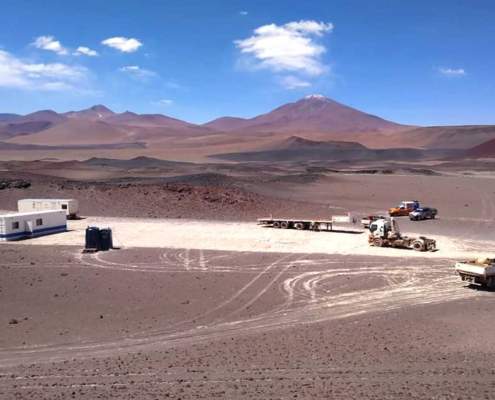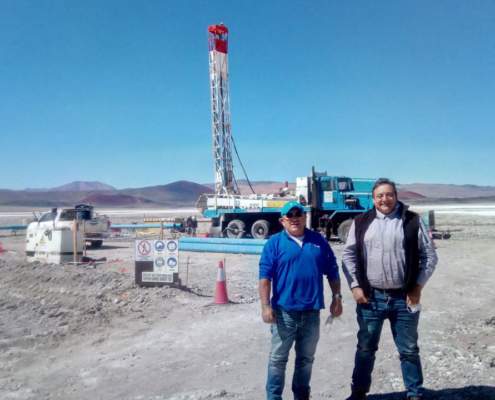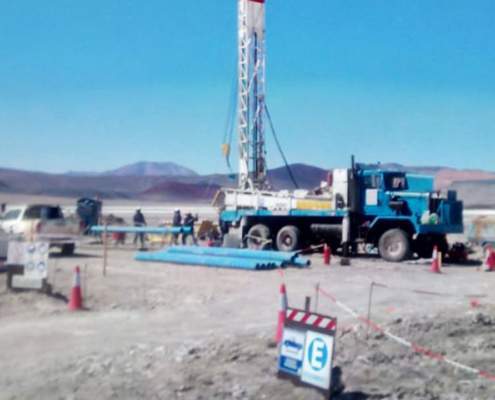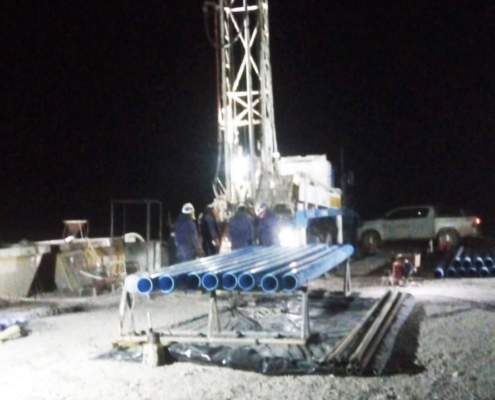Ultra Lithium Provides an Update On Drilling at The Laguna Verde Brine Lithium Project in Argentina
May 30, 2022
Vancouver, BC – Ultra Lithium Inc. (TSX-V:ULT, OTCQB: ULTXF and Frankfurt: QFB) (“Ultra Lithium” or the “Company”) is pleased to provide an update on the drilling work at its 100% owned Laguna Verde brine lithium project in Catamarca Province, Argentina. Drill hole LV22-01 has been drilled to a depth of 210 m with an initial diameter of 9 7/8 inches to carry out geophysical studies. Later, the drill hole will be widened to 12 inches for well development, brine sampling and pumping testwork to check brine aquifer potential for future development. The geophysical study of the well indicated the presence of a continuous brine aquifer comprising of mainly clastic sediments from 13.9 meters to 205 m depth with a marked hydrothermal presence towards the deeper section. The aquifer is still open at depth.
Downhole Geophysical Survey Highlights:
- The temperature of the well shows an increase with depth that would not only correspond to the increase due to the geothermal gradient but also to a hydrothermal activity towards the bottom of the well.
- Well conductivity generally shows an average reading of 79352.6 µS/cm. From approximately 198 m, a strong decrease in the measurement is observed (reaching a minimum of 38020 µS/cm) which also suggests hydrothermal activity.
- The resistivity curves show that before approximately 13.9 m the formation water would be brackish, while below the formation water would be brine. Between 13.9 m and 169.3 m, the formation resistivity is quite homogeneous with an average value of 2.15 ohm.m.
- From 169.3 m to 205.4 m, the formation resistivity decreases until it reaches an average value of 1.72 ohm.m. This behavior could be due to the fact that it corresponds to a washed area of the well and the measurement was attenuated for the same reason or because this sector naturally has better porosity.
- According to the measurements obtained in the GR, resistivity, total porosity and specific yield logs, four sub intervals were established within a larger single aquifer, out of which intervals 1 and 3 stands out for the best specific yield performance.
- Interval 1: from 0 m to 75.3 m depth presents excellent measurements of total porosity and specific yield with average values of 31% and 19%, respectively.
- Interval 2: from 75.3 m to 130 m, average total porosity is 27%, the specific yield curve shows a strong heterogeneity (due to the variation of the fine matrix in the sandy facies) with values ranging between 2% (minimum value) and 19% (maximum value).
- Interval 3: from 130.5 m to 169.3 m deep, with average total porosity of 28%, however, in the sector where the sands with little matrix are found, it can reach a value of 30%. Good measures of specific yield are found in this range, with a maximum value of 22%.
- Interval 4: from 169.3 to 205.3 m deep, this interval corresponds mainly to medium to coarse textured sandy facies. This sandy package corresponds to a strongly washed zone, therefore, the total porosity measurements are not reliable as they are totally affected by the well mud. The resistivity curves are smooth but show a small decrease in measurements with an average value of 1.72 ohm.m. Regarding the temperature and conductivity of the well, these would indicate a possible entry of hydrothermal fluid due to the anomalous increase in temperature and decrease in conductivity.
The geophysical study work was carried out by the Zelander BrineField Services company based in Salta, Argentina. Well LV22-01 is undergoing development work for completion and brine sampling.
Dr. Weiguo Lang, CEO of Ultra Resources, stated that, “The results of geophysical survey on the first drill hole showed all strong positive parameters of the Laguna Verde brine lithium project. The survey identified a single brine aquifer with multiple zones of varying porosities and permeabilities indicating potential for producing high volume of brine fluids from this well. We are getting ready for collecting clean brine samples through installation of pipes, cleaning up the hole and carrying out pumping tests as soon as possible. The Company expects the similar high-grade surface lithium results at depth. As the first drill hole aquifer is still open at the drilled depth of 205 m, the Company is planning to drill the next drill holes down to 400 m or deeper. The Company has become confident that the Laguna Verde Salar will be one of the major brand-new discoveries of lithium bearing brine resources in the part of world known Lithium Triangle.”
Laguna Verde Brine Lithium Project Highlights
Laguna Verde is a new brine lithium discovery where exploratory sampling conducted by ULT has shown lithium values in the range of 34.2 to 1,270 milligrams per liter (mg/L) – (see ULT press release dated February 2, 2018). The Company’s previous exploration work from 2017-2021 included surface brine sampling, ground geophysical surveys and bench scale evaporation testwork. The Laguna Verde mineralized brines are marked by low magnesium to lithium ratios, in the range of zero to 10.2 which can result in lower production costs .
In 2018, the Company also completed a 39.2-line- kilometers of ground geophysical survey. The survey results indicate high value brine lithium exploration targets in a salar core area of 3.4 square kilometers within a 23 square kilometre, 100 to 150-meter-thick sedimentary basin with the potential to host lithium brines. Interpretation of gravity survey data show a major fault system exists to the east of the Laguna Verde Salar and also indicates the presence of a 2.4-kilometer-thick Cenozoic basin, which requires further exploration.
In 2018, a bench scale evaporation test of approximately 4,000 litres of brine sampled from Laguna Verde was carried out in Ultra Argentina’s laboratories located in Salta. The density of the original brine sample was 1156 and its lithium concentration was 391 ppm. Two types of evaporation tests were conducted. The first test included evaporating 179 litres of brine sample in an external pool located outside to match natural evaporation conditions. The results indicate that in a period of five months, the brine volume was reduced from 16 cubic metres (m3) to 3 m3 and lithium concentration increased from 391 to 6,760 ppm. Major salts produced during this process were Halite, Felsobanyaite, Silvite, Lithium Sulfate and Potassium, Carnalite, Kainite and Gypsum. The second test was conducted inside in controlled conditions. The results indicated that the original brine volume of 2,326 m3 was reduced to 85.06 m3 and the lithium concentration increased from 391 to 7,370 ppm (see ULT press release dated September 24, 2021).
Qualified Person
The technical information contained in this news release has been reviewed and approved by Afzaal Pirzada, P.Geo., a qualified person, as defined by NI 43-101 who works as Vice President Exploration of the Company.
About Ultra Resources Inc.
Ultra Lithium Inc. is an exploration and development company with a focus on the acquisition and development of lithium, gold, and copper assets. The Company holds a brine lithium property in Argentina, hard rock spodumene type lithium properties at the Georgia Lake / Forgan Lake area in northwestern Ontario, Canada, and a brine lithium property in the Big Smoky Valley, Nevada, USA. The Company also holds other gold and base metals properties in Argentina.
On behalf of the Board of Directors
Kiki Smith, CFO
For further information, please contact:
Kiki Smith, CFO
T: +1-778-968-1176
E: kiki@ultralithium.com
W: www.ultralithium.com
Or view the Company’s filings at www.sedar.com
Cautionary Statement Regarding “Forward-Looking” Information
Some of the statements contained in this press release are forward-looking statements and information within the meaning of applicable securities laws. Forward-looking statements and information can be identified by the use of words such as “plans”, “expects”, “intends”, “is expected”, “potential”, “suggests” or variations of such words or phrases, or statements that certain actions, events or results “may”, “could”, “should”, “would”, “might” or “will” be taken, occur or be achieved. Forward-looking statements and information are not historical facts and are subject to a number of risks and uncertainties beyond the Company’s control. Actual results and developments are likely to differ and may differ materially, from those expressed or implied by the forward-looking statements contained in this news release. Accordingly, readers should not place undue reliance on forward-looking statements. The Company undertakes no obligation to update publicly or otherwise revise any forward-looking statements, except as may be required by law.
Neither TSX Venture Exchange nor its Regulations Services Provider (as that term is defined in policies of the TSX Venture Exchange) accepts responsibility for the adequacy or accuracy of this release.

